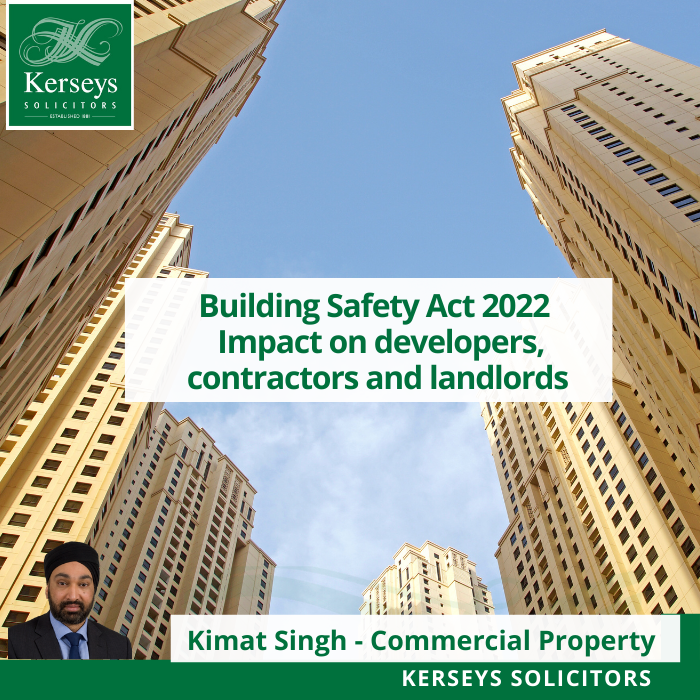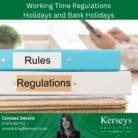Building Safety Act 2022
Building Safety Act 2022
Impact on developers, contractors and landlords
The Building Safety Act 2022 is the Government’s response to the tragic Grenfell fire, and the first parts of the Act came into force on 28 June 2022.
While the focus has been on safety in residential units, developers and landlords of mixed-use properties will also need to comply with the new rules or they may need advice on historic developments since 1992.
The long-term impact of the Building Safety Act 2022 will be to overhaul the approach to fire risk in residential blocks, introducing tighter regulation in design, planning and construction, as well as ongoing responsibility for building owners. It also makes immediate changes to deal with the issue of who pays to replace defective cladding. Much of the Act is focused on what are referred to as ‘higher risk’ residential buildings but there will also be broad changes to the fire safety regime for many other buildings.
‘Building safety must be the highest priority for anyone developing, converting or investing in residential property,’ according to Kimat Singh, head of the commercial property team with Kerseys Solicitors LLP. As well as creating stringent standards for the future, the Building Safety Act looks back to work done since 1992, so anyone who has been active in this market over the last 30 years will need legal advice to get up to speed.
The aims of the Act
It will eventually affect three broad areas: design and construction of new builds and residential conversions; management of safety in residential blocks once occupied; and remedying historic defects which could make residential buildings unsafe.
Design and construction
The essential parts of the new building safety regime are in place, but the details will be worked out in consultation and brought into force over the next 18 months or so. The new rules will apply to what the Act defines as ‘higher risk buildings’, which are buildings that:
- are either 18 metres high or have at least 7 storeys; and
- contain at least two residential units.
This will bring mixed-use developments into the new regime, as well as purely residential blocks, as long as they meet the height criteria. It is worth noting that purpose-built student accommodation blocks of the specified height will also be included.
When the detail has been worked out and brought into force, developers will have to satisfy the new Building Safety Regulator at three ‘gateway’ stages in a building or conversion project: planning; pre-construction; and pre-completion. At the planning stage, the developer will be required to submit a fire statement with the planning application. Before construction starts, the regulator will require full design details, with details on how the building will comply with the relevant regulations once it has been completed. Once the building work is complete, the regulator will want to see that a range of required safety information has been compiled and will be passed to the building owner. This is being referred to as the ‘golden thread’ of building information and will play a key role in making sure that each owner has the information they need to manage safety properly. It should also ensure that those responsible for design and construction can be identified and remain accountable throughout the life of the building.
Safety in occupied buildings
Once a higher risk building has been completed and is occupied, the focus of the new building safety regime shifts to monitoring and managing risks from the spread of fire or structural failure (which could lead a building to collapse). Responsibility will lie with the Accountable Person (or persons, because there could be more than one depending on how the building has been subdivided). This will broadly be whoever controls or is obliged to repair the common parts, structure or exterior, so is likely to be the long-term building owner. The Accountable Person can be an individual, a partnership or a company. Where there is more than one Accountable Person, they will have a duty to cooperate with each other. The duties of an Accountable Person will include assessing and managing building safety risks, compiling and maintaining the golden thread information and producing a residents’ engagement strategy. If an Accountable Person is in breach of these obligations, they may be prosecuted.
There is already a similar role in relation to commercial buildings and the common parts of residential blocks with the Responsible Person. The Building Safety Act amends the rules which apply to Responsible Persons, who will continue to be responsible for fire safety in buildings which do not fall into the definition of higher risk buildings. The changes will include more stringent requirements for training and competence and an obligation to pass on information to a successor, as well as a duty to cooperate with Accountable Persons.
Defective cladding
For obvious reasons, much of the public discussion of building safety has focused on the issue of dangerous cladding. The new rules on dealing with pre-existing defects came into force on 28 June 2022. There are some important points to note here:
- These rules apply to slightly smaller buildings than those covered by the main building safety regime. A ‘relevant building’ for the provisions on defects must be either 11 metres high, or have at least five storeys, and contain at least two dwellings.
- It is now illegal for landlords of relevant buildings to charge tenants for the cost of removing or replacing unsafe external cladding – even sending them a bill is outlawed.
- There is also a cap on the amount a landlord can recover from tenants for dealing with non-cladding defects that might cause fire to spread or a building to collapse. This depends on the status and financial position of the landlord and the value of the lease, so landlords should get legal advice to work out what they can legally charge back to tenants.
- The time limit for claims for defective work and products used in building or converting residential property has been extended, so that courts can now look back 30 years. This is a significant shift in policy and will make many more developers, building contractors and owners potentially liable for unsafe buildings. The first court decision on this was published in July 2022, with a design and build contractor being held liable for specifying and installing unsafe cladding on residential blocks between 2005 and 2008. All decisions like this will depend on what the relevant contracts said, but this case is expected to set the tone for those involved in building and converting residential blocks to be held to account.
For further information, please contact Kimat Singh, Head of the Commercial Property team at Kerseys Solicitors in Ipswich on tel:01473213311 or Kerseys Solicitors in Colchester on tel:01206584584 or email us at info@kerseys.co.uk, alternatively you can visit our web site and click “Call Me Back” and a member of our commercial property team will be happy to contact you.
#law #legaladvice #property #commercialproperty #buildingsafetyact2022







